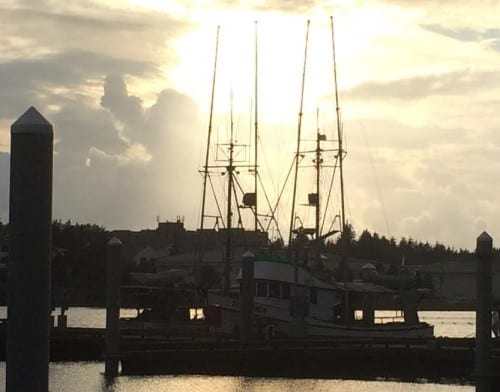
The state is expecting a better year for king salmon in Southeast Alaska, which in all likelihood means a better year for all harvesters, the commercial troll fleet in particular.
Overall, about 60,000 more chinook will be available to catch in Southeast Alaska in 2022 (261,300) than last year (201,100) – welcome news, especially for commercial trollers, who will take the lion’s share of the fish (44,700).
The catch limit is set by rules negotiated under the Pacific Salmon Treaty, an agreement between the US and Canada that governs the harvest of kings, who originate in the big river systems from Oregon up the Canadian coast to Alaska, but commingle in the Gulf of Alaska.
Grant Hagerman, troll fish management biologist in Sitka, says there’s no single explanation for the increase in abundance.
“Definitely in winter, and in summer, we have a mixed stock,” Hagerman said. “We’ve got Alaska stocks, Canada stocks and southern US stocks. And so it’s more a picture of Coastwide abundance. And so from this year, it looks like – I’m not pinning down any particular stock – but just in general, that the abundance would be up for 2022.”
The formula for determining abundance is based on the success of commercial trollers during the first half of the winter fishery, beginning in mid-October. How many boats get out, and how many chinook they land allow biologists to calculate the rate of harvest, called the CPUE, or Catch Per Unit Effort. Hagerman says this has proven to be a reliable indicator of abundance later in the summer.
“What we have seen for December and January out here in Sitka is when the weather cooperated and they were able to get out that those catch rates have continued to be good, and much better than what we’ve seen going all the way back to 2001 for those two months,” said Hagerman. “So that’s it is promising that what we were seeing in October-November is a very accurate picture of what we’re going to see for abundances next year.”
The ATA responds to the 2022 Chinook forecast:
“Trollers are grateful for the larger quota and subsequent increased Chinook harvest opportunities this year. The SEAK small boat hook and line troll fishery has taken considerable economic hits from Stocks of Concern Management and from the one-sided 2019 Pacific Salmon Agreement in which SEAK gave up another 13.2% of our historic Chinook harvest (not to be confused with Allocation) (Economic Impact of the Pacific Salmon Treaty on the Alaska Troll Fleet, Dec,2019 McDowell). Since most trollers live in rural SEAK, the 40,000 increase in Chinook harvest will help SEAK’s Covid-beleaguered rural economies.”
Matt Donohoe, President Alaska Trollers Association
The Southeast troll fleet’s share of this year’s increased harvest allocation is nearly 45,000 kings (44,700), and pushes their total allocation up to over 190,000 fish. Summer trolling opens on July 1, and managers aim to harvest 70-percent of the allocation then, and the rest in August. The openers are often very short, just a few days. Although it’s too early to be specific, Hagerman believes the additional 45,000 fish will mean longer openers.
“That could translate into — depending on whether some of it was caught in July and some was caught in August — about 2, 3, or 4 more potential fishing days.” Hagerman said. “But again it’s really all kind of dependent on on how those catch rates are.”
Economically, it’s also hard to know the exact impact on the industry’s revenue. Kings sell for about $10/pound in winter, and somewhat less in summer, although the fish tend to be larger. Hagerman says the additional 45,000 kings are going to make a dent.
“That’s a fairly big financial increase, I think’ from 2021,” he said.
Other groups will share in the increase, but none quite as much as trollers. Seiners and gillnetters combined take about 8-percent of the all-gear catch limit, commercial set netters take an even smaller share, and then trollers and sport fishermen divide the rest 80/20.
The total value of the commercial chinook fishery in Southeast runs to the millions – $13.2 million in 2020, $11 million in 2019, and $14.6 million in 2018.






























